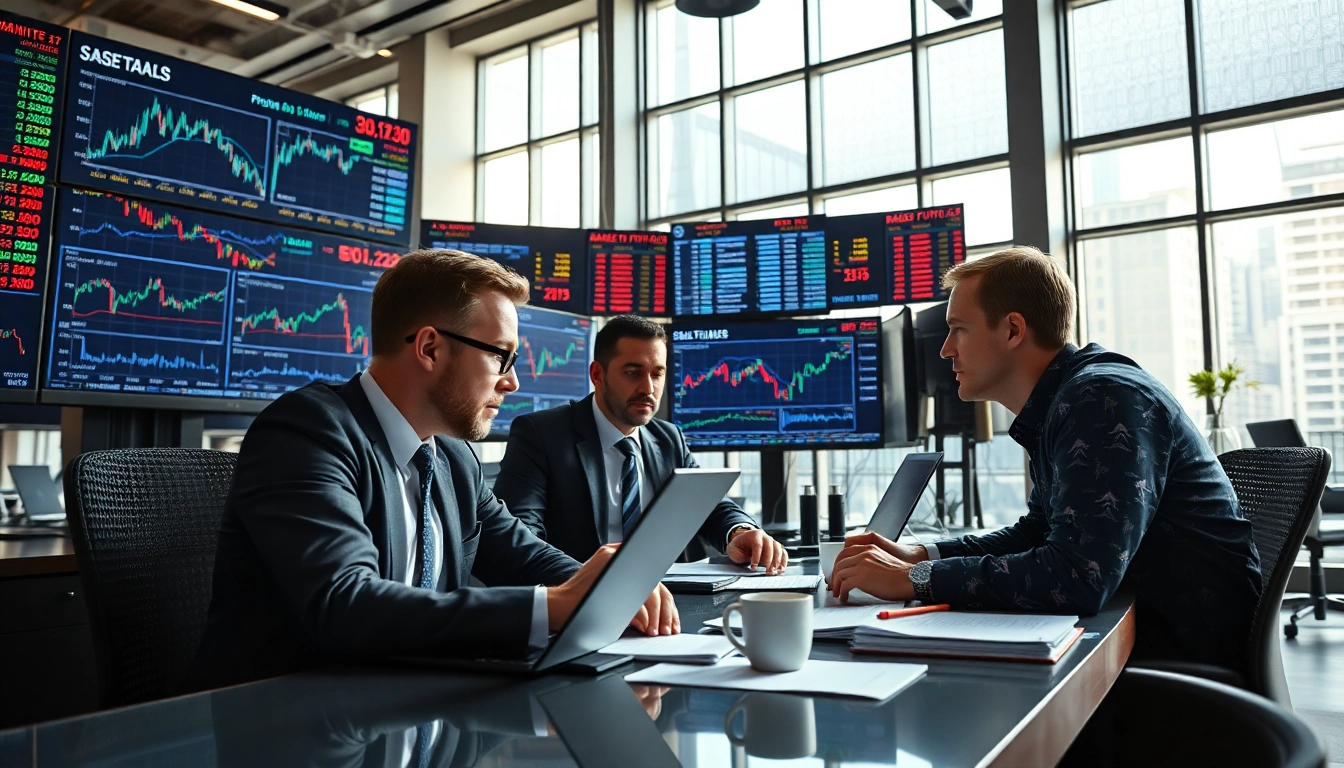Understanding Trade Futures and Their Role in Financial Markets
What are Trade Futures?
Trade futures are contracts obligating the buyer to purchase, and the seller to sell, a particular asset at a predetermined price at a specified future date. This commonly traded financial instrument is utilized across various market sectors, including commodities, currency, and indexes. Unlike traditional investments that involve ownership of physical assets, futures contracts focus on price speculation and are often employed for both hedging against price fluctuations and speculative trading. The dynamic nature of trade futures makes them an essential component of modern financial markets.
In essence, when engaging in trade futures, traders predict future movements in asset prices, allowing them to benefit from market volatility. They can leverage their capital through margin trading, enhancing potential returns—but equally exposing themselves to heightened risks.
The Importance of Trade Futures in Economic Stability
Trade futures play a pivotal role in the economic landscape. They contribute to price discovery, which helps in determining the future price direction of assets based on current market forces. By allowing participants to express their expectations about the future, futures markets offer essential signals to producers, consumers, and investors. This price discovery mechanism enhances liquidity and increases market efficiency, fostering economic stability.
Moreover, trade futures are critical for risk management. Farmers and manufacturers can use futures contracts to lock in prices for their products, hedging against unexpected price movements that could affect their bottom lines. Likewise, institutional investors leverage these instruments to manage portfolios, mitigating against market volatility while seeking better returns.
How Trade Futures Function: Key Concepts Explained
The functioning of trade futures is anchored in a few key concepts: margin, leverage, and settlement. Margin refers to the collateral required to initiate a futures trading position, ensuring that both parties can meet contract obligations. Leverage amplifies this by allowing traders to control large positions with relatively small amounts of capital.
Futures contracts can settle in two primary ways: physical delivery and cash settlement. In physical delivery, the actual asset is exchanged on the contract’s expiration date, whereas, in cash settlement, the difference between the contracted price and the market price is exchanged. This determines the net gain or loss for the trader without necessitating physical asset transfer.
Determining Market Trends in Trade Futures
Technical Indicators for Trade Futures Analysis
Technical analysis involves evaluating historical price data to forecast future price movements, using various tools and indicators. Traders utilize these indicators to identify trends, gauge market sentiment, and establish entry and exit points for futures trades. Popular technical indicators include Moving Averages, Relative Strength Index (RSI), and Fibonacci retracement levels, among others.
Moving Averages smooth out price data over a specified period, making it easier to identify trends. The RSI, on the other hand, evaluates the speed and change of price movements, helping traders ascertain whether a market is overbought or oversold. By integrating these technical indicators into trading strategies, traders stand a better chance at deciphering market trends and making informed trading decisions.
Fundamental Factors Influencing Trade Futures Prices
Fundamental analysis complements technical analysis by examining underlying economic indicators that might influence trade futures prices. This involves assessing various factors such as supply and demand dynamics, geopolitical events, and economic indicators like employment rates and Gross Domestic Product (GDP) figures.
For instance, an unexpected increase in crude oil inventory can affect oil futures prices adversely. Conversely, a robust economic outlook typically leads to increased demand for commodities, driving up futures prices. Understanding these fundamental factors allows traders to make better predictions and effectively navigate market conditions.
Interpreting Trade Futures Charts for Better Decision-Making
Charts serve as the foundation for technical analysis in futures trading. Traders rely on various types of charts—such as candlestick, bar, and line charts—to visualize price movements and identify patterns. Each chart type provides distinct advantages depending on the trader’s strategy and the timeframe of analysis.
Candlestick charts, for example, depict price action within specific timeframes, showcasing opening, closing, high, and low prices. This format allows traders to discern bullish and bearish patterns more readily. Chart patterns, including head-and-shoulders and double tops or bottoms, can also signal potential market reversals or continuations, aiding in decision-making.
Effective Strategies for Trading Futures
Risk Management Techniques in Trade Futures
Risk management is an essential element of successful futures trading. Given the inherent volatility of futures markets, employing effective risk management techniques can protect traders from significant losses. Common strategies include setting stop-loss and take-profit levels to manage potential risks while optimizing profit opportunities.
Additionally, portfolio diversification across different asset classes—such as commodities, stocks, and currencies—can mitigate overall risk exposure. Traders should also consider position sizing, which involves determining the amount of capital allocated to a single trade based on risk tolerance and account size. By carefully managing risk, traders can enhance sustainability and long-term success in their futures trading endeavors.
Developing a Trade Futures Trading Plan
A well-crafted trading plan acts as a roadmap for traders, outlining the specific goals, strategies, and risk management protocols to be followed. When formulating a trading plan, one must define risk tolerance levels, develop entry and exit criteria, and continuously adapt based on market conditions.
Additionally, evaluating past performance and reviewing multiple trades can provide insights into what is working and what needs adjustment. A solid trading plan fosters discipline and keeps emotions in check during volatile market situations, ultimately contributing to improved trading outcomes.
Utilizing Automation in Trade Futures
Automation in trading has gained traction as technology continues to evolve. Automated trading systems, or algorithmic trading, streamline decision-making processes by executing trades based on predefined criteria. This removes subjectivity and emotional elements from trading, enabling traders to react swiftly to changing market conditions.
Moreover, back-testing these automated strategies against historical data allows traders to gauge potential effectiveness before live trading. Automation can be particularly advantageous in futures markets, where real-time data analysis is crucial for capitalizing on rapid price fluctuations.
Common Mistakes in Trade Futures and How to Avoid Them
Emotional Trading: The Pitfalls
Emotional trading is one of the most pervasive pitfalls for futures traders. Decisions driven by fear, greed, or impatience can lead to hasty actions and significant losses. Cognitive biases, such as overconfidence or loss aversion, can impair objectivity and cloud judgment.
To counteract emotional influences, traders should adhere to their trading plans and implement structured trading strategies. Keeping a trading journal can also provide insights into one’s decision-making process and help identify emotional triggers. By fostering awareness and maintaining discipline, traders can minimize the impact of emotional trading.
Neglecting Diversification in Trade Futures Portfolio
Concentration in one asset class can expose traders to heightened risks. Neglecting diversification within a trade futures portfolio can lead to more significant losses during adverse market conditions. To uphold a balanced approach, traders should allocate capital across various futures contracts and market sectors, reducing overall risk exposure.
By diversifying, traders can leverage different market dynamics and capture opportunities across multiple sectors. This not only stabilizes returns but also nurtures long-term portfolio growth.
Ignoring Market Research and Analysis
Overlooking the importance of market research and analysis compromises trading outcomes. Many traders dive into futures trading relying solely on instinct or gut feelings, which can lead to poor decision-making and financial losses.
Consistent and thorough analysis of market trends, current events, and economic indicators is vital for informed decision-making. Traders should dedicate time to ongoing education and staying updated on market developments while utilizing various sources, including financial news, economic reports, and expert analyses, to enhance their understanding of market behaviors.
Evaluating Performance in Trade Futures Trading
Using Metrics to Measure Success in Trade Futures
Establishing benchmarks for measuring trading performance is crucial for ongoing improvement. Common metrics include profit and loss, return on investment (ROI), win rate, and risk-reward ratio. By regularly analyzing these metrics, traders can assess their effectiveness and identify areas needing refinement.
Additionally, comparing performance against market indices or peer performance provides context and perspective to traders, facilitating better risk management and strategy adjustment.
Adjusting Strategies Based on Trade Futures Outcomes
Flexibility and adaptability are essential components of a successful trading strategy. Conditions in futures markets can change rapidly; thus, aligning strategies with real-world dynamics is crucial. Analyzing past trades and outcomes allows traders to discern patterns and make necessary adjustments in their future strategies.
Continual refinement of trading approaches contributes to sustainable improvements in performance, keeping traders in sync with market developments while optimizing profit prospects.
Long-term vs. Short-term Performance in Trade Futures
Understanding the differentiation between long-term and short-term performance in futures trading is vital. Short-term trading focuses on capitalizing on immediate price movements, while long-term trading seeks to benefit from broader market trends over an extended duration.
Both approaches come with distinct challenges and opportunities. Short-term traders require swift decision-making abilities and thorough technical analysis, whereas long-term traders often emphasize fundamental analysis and macroeconomic factors. Balancing between both approaches enables traders to remain flexible, optimize strategies, and capitalize on varying market conditions.



